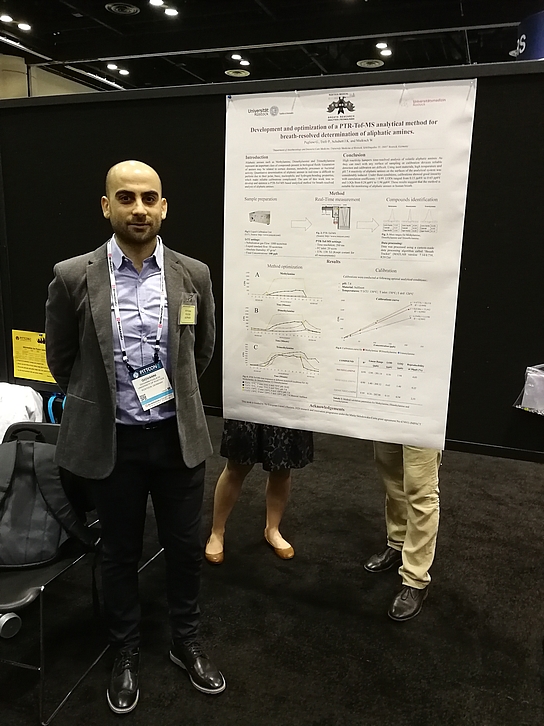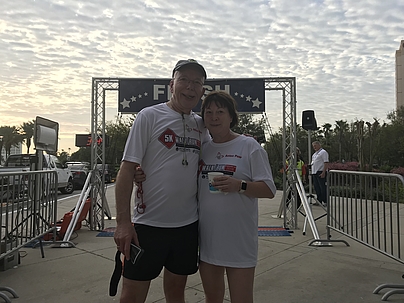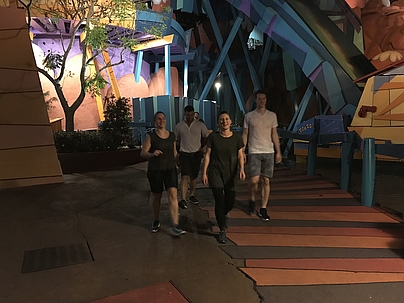PittCon Orlando FL 26.02. - 01.03.2018
Programm und weitere Informationen
Networking Session
| Facilitator: | Jochen Schubert - University Medicine of Rostock |
| Session Title: | Non-invasive Biomedical Analysis |
| Event Type: | Networking Session |
| Event Title: | How can innovative Instrumentation promote biomedical research and medical applications? |
| Co-Authors | Wolfram Miekisch, Phillip Trefz |
| Affiliation: | Rostock University Medical Center |
| Date: | Tuesday, February 27, 2018 |
| Start Time: | 11:00 pm |
| Location: | Orange County Convention Center Orlando, Florida, USA |
Abstract Content
| During recent years, progress in analytical science enabled amazing developments in the biomedicine. In VOC research, direct MS techniques such as ion-funnel TOF MS provide detection limits of whole VOC patterns to the sub pptV level. Novel (nano-)sensor based techniques allow detection of marker compounds at the bedside.This networking session intents to address the potential of these techniques for basic research and for clinical applications. Latest developments in analytical chemistry for non-/ minimally invasive determination of drugs and biomarkers in various biological matrices will be addressed. Advantages and pitfalls of actual technical developments will be discussed. Special focus will be laid upon problems of ultra high sensitivity and contamination induced bias. |
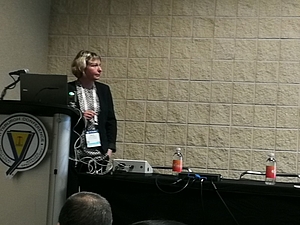
Oral Sessions
| Author Name: | Beate Brock - University Medicine of Rostock |
| Session Title: | A Closer Look at Clinical Toxicology Screening in Different Matrices |
| Event Type: | Oral Sessions |
| Event Title: | Breath Gas Monitoring of Drug Metabolites in Real Time - PTR-ToF-MS Analysis of Prilocaine Concentrations by o-toluidine |
| Co-Authors | Svend Kamysek, Wolfram Miekisch, Jochen K Schubert, Phillip Trefz |
| Affiliation: | Rostock University Medical Center |
| Date: | Monday, February 26, 2018 |
| Start Time: | 03:05 pm |
| Location: | Orange County Convention Center Orlando, Florida, USA |
Abstract Content
| Real time breath gas monitoring by hyphenated MS-techniques opens new perspectives for applications in the clinical field. A rare but potentially life-threatening side effect in the use of the local anaesthetic prilocaine (N-(2-Methylphenyl)-2-(propylamino)-propanamid) is the generation of methaemoglobin. The diagnosis is currently only possible by means of blood tests. Especially for risk patients rapid and non-invasive tests would be desirable. Using a pig model, we induced methaemoglobinemia via application of dimethyl aminophenol and prilocaine or natrium nitrite and prilocaine. Continuous real time breath gas monitoring for non-invasive determination of breath VOCs was performed by PTR-ToF-MS. The concentrations of the main metabolite o-toluidine were quantified in the alveolar breath. O-toluidine could be determined with excellent linearity (R2=0.99) in concentrations up to 100 ppbV. Limits of detection and quantification were 0.09 ppbV and 0.23 ppbV, respectively. The o-toluidine concentrations determined in pigs' breath by means of PTR-ToF-MS were in the range of 0-23.5 ppbV. The administration of prilocaine intravenously was clearly reflected with a time lag of a few minutes by the detection of o-toluidine in the respiratory gas. Repetitive injections of prilocaine induced consecutive increases in breath o-toluidine concentrations. PTR-ToF-MS enables continuous real time determination of o-toluidine in breath gas after intravenous administration of prilocaine. In a perspective, detection of prilocaine induced methaemoglobinemia and avoiding of related hypoxia might be possible by non-invasive breath tests. |
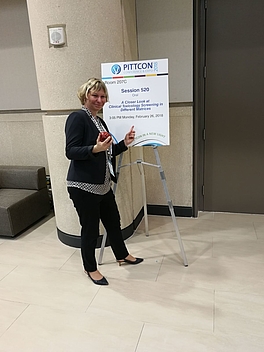
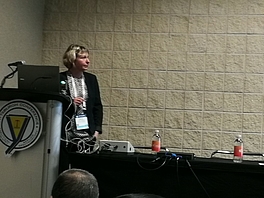
Poster Sessions
| Author Name: | Ann-Christin Bischoff - University Medicine of Rostock |
| Session Title: | Bioanalytical - GC/MS |
| Event Type: | Poster Sessions |
| Event Title: | Analysis of VOC Profiles Provides Immediate, Destruction Free Information on Cell Growth |
| Co-Authors | Robert David, Wolfram Miekisch, Peter Oertel, Christian Rimmbach, Jochen K Schubert, Pritam Sukul, |
| Affiliation: | Rostock University Medical Center |
| Date: | Tuesday, February 27, 2018 |
| Start Time: | 10:00 am |
| Location: | Orange County Convention Center Orlando, Florida, USA |
Abstract Content
| GC-MS analysis of volatile organic compounds (VOCs) from headspace over cell cultures has been described as useful tool for the distinction of different cell lines. However, physiological conditions such as cellular density, growth phase can influence VOC profiles. Assessing these parameters still requires expensive and often invasive and destructive biochemical methods. To determine the effect of cell status on VOC profiles, growth of a fast proliferating murine cell line was monitored over 72 h. 20 ml headspace were pre-concentrated every 24h with polymer needle trap devices (NTDs) in triplicate. Pure medium samples were analyzed in parallel as a negative control. NTDs were analyzed with an Agilent 7890A gas chromatograph coupled to an Agilent 5975C inert XL MSD with triple axis detector. To reduce effects of biological variance between repetitions data were normalized. The variance of the analytical method could be reduced below 10% by using a hermetically closed, inert sampling box and polymer NTDs. 14 VOCs showed differences between negative controls and cell cultures. Two compounds could be correlated to cell growth. Most VOCs were consumed during growth. VOC patterns of cell cultures depended on cellular growth and emissions from media. Substances emitted from cell cultures mirror cell proliferation and metabolic status. Determination of VOC profiles from headspace over cell cultures may provide immediate, destruction free information on cell status. |
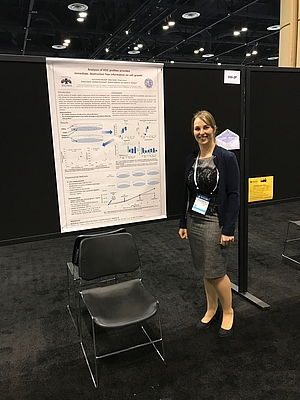
Poster Sessions
| Author Name: | Selina Traxler - University Medicine of Rostock |
| Session Title: | Gas Chromatography/Mass Spectrometry - Bioanalytical and Clinical |
| Event Type: | Poster Sessions |
| Event Title: | Volatile Emission of Bacterial Cultures Mirror Effects of Growth Kinetics |
| Co-Authors | Gina Barkowsky, Ann-Christin Bischoff, Wolfram Miekisch, Jochen K Schubert |
| Affiliation: | Rostock University Medical Center |
| Date: | Tuesday, February 27, 2018 |
| Start Time: | 10:00 am |
| Location: | Orange County Convention Center Orlando, Florida, USA |
Abstract Content
| Introduction: Bacteria emit a broad spectrum of volatile substances. In a perspective VOC patterns may therefore help to recognize bacterial growth and infections non-invasively. This study was intended to characterize VOC profiles from Streptococcus pyogenes cultures with respect to proliferation phases. Method: 20 ml of the headspace above bacterial cultures were sampled bidirectionally 1, 4, 5, 6, 7, 10, 24, 48 and 72 hours after inoculation onto polymer needle trap devices (NTDs). VOCs were thermally desorbed from NTDs and further analysed by GC-MS. Bacterial growth was assessed through determination of optical density of bacterial cultures. At every time point, headspace of three bacteria cultures were sampled. In parallel three media samples were taken as control. Results: VOC profiles mirrored growth kinetics. Some VOCs were only detectable in the headspace of S. pyogenes and not in the medium. The heatmap indicates that some aldehydes, alkanes, pyrazines accumulated after 5 and 6 hours. After this maximum, concentrations of most substances decreased again. Most alcohols and ketones reached their maximum after 72 hours. First accumulation of VOCs takes place when growth of Streptococcus pyogenes changes from expontentional to stationary growthphase. Discussion: Time course of VOC patterns mirrored active adjustments of metabolic pathways during bacterial proliferation.. In addition, VOC determination may reveal metabolites having toxic or virulence associated properties. VOC analysis could be used for non-invasive monitoring of growth and metabolism in bacterial cultures. |
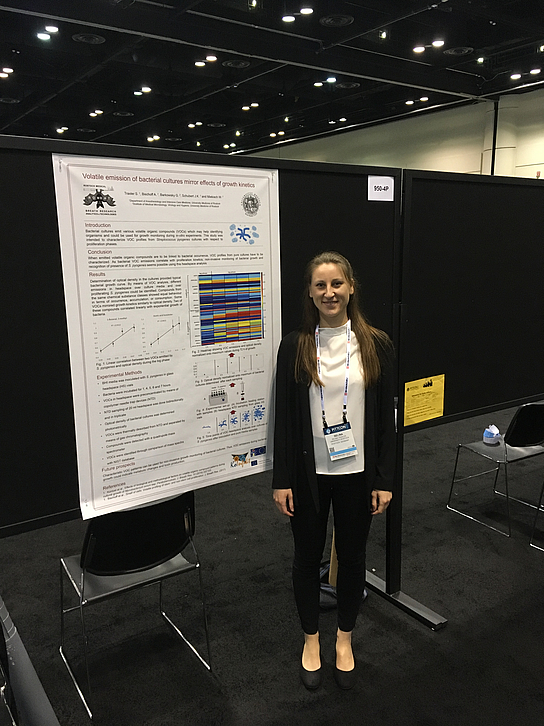
Poster Sessions
| Author Name: | Peter Oertel - University Medicine of Rostock |
| Session Title: | Bioanalytical - Mass Spectrometry |
| Event Type: | Poster Sessions |
| Event Title: | VOC Profiling in Cattle via Real-Time Breath by Means of PTR-TOF-MS |
| Co-Authors | Heike Köhler - Friedrich-Löffler-Institut, Anne Küntzel - Friedrich Löffler Institut, Wolfram Miekisch, Petra Reinhold - Friedrich-Löffler-Institut, Jochen K Schubert |
| Affiliation: | Rostock University Medical Center |
| Date: | Tuesday, February 27, 2018 |
| Start Time: | 10:00 am |
| Location: | Orange County Convention Center Orlando, Florida, USA |
Abstract Content
| As profiles of breath biomarkers in animals may significantly differ from those in humans, influences on VOC exhalation have to be characterized when translational animal models are to be established. In this study changes in VOC composition in breath of cattle were assessed over the day by means of proton-transfer-reaction time-of-flight mass spectrometry (PTR-ToF-MS). Breath was sampled for three minutes every 2 hours over 10 hours via a tightly fitting face mask, connected to PTR-TOF 1000. Discrimination between inspiratory and expiratory breath phases was realized through a custom made data processing algorithm. Thirty-six VOCs were monitored over the period of 10h. Substance specific changes over the day were observed (e.g. (C[3]H[6]O)H{+} increased by 60% and (C[4]H[8]O)H{+} by 150%) Due to the sudden increase of some VOCs during the physiological eructation some substances (e.g. (C[5]H[10])H{+}) increased up to 45 fold and returned to initial values within the following breaths. Decrease after eructation was substance specific (from 4% to 24% per breath). An additional data algorithm called 'Burb Tracker' was developed to discriminate eructation and normal breath phases. Day profile of VOC's by means of real-time analysis allowed detection of metabolic changes as well as recognition of specific phases in the breath profile such as burbs. Data processing algorithms enable discrimination of VOCs coming from rumen or breath. In a perspective, the results enhance basic understanding of the origin of exhaled VOCs in animals. |

Poster Sessions
| Author Name: | Pritam Sukul - University Medicine of Rostock |
| Session Title: | Biomedical - Mass Spectrometry |
| Event Type: | Poster Sessions |
| Event Title: | Effects of Spontaneous and Paced Breathing onto Exhalation of Volatile Organic Compounds (VOCs) |
| Co-Authors | Svend Kamysek, Wolfram Miekisch, Giovanni Pugliese, Jochen K Schubert, Phillip Trefz, Karim Zanaty |
| Affiliation: | Rostock University Medical Center |
| Date: | Tuesday, February 27, 2018 |
| Start Time: | 10:00 am |
| Location: | Orange County Convention Center Orlando, Florida, USA |
Abstract Content
| Breath analysis holds promise for non-invasive diagnosis. During breath sampling, subject's physiology (breathing patterns or posture) affects VOC exhalation and may override true pathophysiological impression. Sampling standardization is thus crucial. As paced and spontaneous breathing are often used for sampling, we applied real-time mass spectrometry to investigate their effects onto VOC exhalation. After having ethical approval and signed informed-consent, we applied an online PTR-ToF-MS-8000 [PDrift=2.3mbar, TDrift=75°C, VDrift=610Volt, E/N=139Td, Time-resolution=200ms] for breath-resolved VOC measurements in 20 healthy humans during continuous side-stream sampling [flow=20ml/min]. Oral breathing pattern was changed after every 3 min; i.e. spontaneous→ paced (12breath/min)→ spontaneous. Custom 'Breath tracker' algorithm was used to assign alveolar and inspiratory concentrations of VOCs. Simultaneously, we performed continuous spirometry and capnometry. Ventilation altered instantly, which thereby changed VOC exhalations. During paced breathing, tidal-volume and minute-ventilation increased by 35% and 25%, respectively and end-tidal PCO2 gradually decreased by 10%. Alveolar isoprene concentrations decreased significantly mirroring CO2 exhalation. Exogenous furan closely mirrored isoprene. Despite increased minute-ventilation, endogenous acetone remained unaffected. Oral H2S, gut originated C2H6S mirrored acetone. Smoking related acetonitrile and environmentally accumulated benzene and limonene also remained constant. All measured parameter returned to initial level during the final phase of spontaneous breathing. Changes in breathing patterns immediately affected exhaled VOC concentrations. These effects were compound specific and depended on respiratory parameters and physico-chemical properties of the VOCs. Reliable sampling must define either spontaneous or paced breathing before clinically interpreting VOC concentration changes as breath biomarkers. |

Poster Sessions
| Author Name: | Markus Trautner - University Medicine of Rostock |
| Session Title: | Biomedical - Mass Spectrometry |
| Event Type: | Poster Sessions |
| Event Title: | SPME-GC-MS Mapping of VOC Excretion in Lungs and Bronchi |
| Co-Authors | Patricia Fuchs, Svend Kamysek, Wolfram Miekisch, Jochen K Schubert |
| Affiliation: | Rostock University Medical Center |
| Date: | Tuesday, February 27, 2018 |
| Start Time: | 10:00 am |
| Location: | Orange County Convention Center Orlando, Florida, USA |
Abstract Content
Background: Breath analysis holds promise for noninvasive in vivo monitoring of disease related processes. However, the influenceof physiological parameters on the composition of exhaled air affects concentrations of VOC profiles. Volatile substances may be released via the alveoli, the bronchial mucosa or from the upper airways. The aim of this study was the systematic investigation of the influence of different sampling sites in the respiratory tract onto VOC concentration profiles. Methods: After ethical approval breath samples from 20 patients undergoing bronchoscopy for various reasons were collected from different sites in the airways. For each position in the respiratory tract 30 mL breath gas were withdrawn by means of gastight glass syringes through the bronchoscope channel. 10 mL were used for VOC analysis; 20 mL for PCO2 determination. Samples were pre-concentrated by solid-phase micro-extraction and analyzed by gas chromatography-mass spectrometry. PCO2 was determined in a conventional blood gas analyzer. VOC concentrations were normalized onto the corresponding PCO2. Results: After quantification and normalization changes in substance concentrations between different sampling sites were observed. Acetone concentrations were 16% higher in proximal sites when compared to more distal sampling sites. Isoprene concentrations decreased by 9% when passing from distal to proximal sampling sites. Isopropanol as external disinfectant showed high levels in room air but remained low in patients’ respiratory tract. Blank bronchoscope measurements did not show any contaminations. Conclusion: Increased concentrations in the upper respiratory tract may be explained through substance excretion from bronchial mucosa while decreased concentrations could result from adsorption. Mapping of VOC profiles may provide novel insights into substance specific exhalation kinetics and mechanisms. |

Poster Sessions
| Author Name: | Giovanni Pugliese - University Medicine of Rostock |
| Session Title: | Biomedical - Mass Spectrometry |
| Event Type: | Poster Sessions |
| Event Title: | Development and optimization of a PTR-Tof-MS analytical method for breath-resolved determination of aliphatic amines. |
| Co-Authors | Phillip Trefz, Wolfram Miekisch, Jochen Schubert |
| Affiliation: | Rostock University Medical Center |
| Date: | Tuesday, February 27, 2018 |
| Start Time: | 10:00 am |
| Location: | Orange County Convention Center Orlando, Florida, USA |
Abstract Content
Aliphatic amines represent an important class of compounds that can be found in biological fluids. Amines in exhaled breath can be related to disease, metabolic processes and bacterial activity. The high reactivity of aliphatic amines induce problems in sample preparation, analysis and quantification. Real-time analysis by means of direct mass spectrometric techniques represent an innovative approach to avoid problems related to sample preparation and storage.
We developed a method for real-time breath monitoring of methylamine, dimethylamine and trimethylamine using a PTR-Tof-MS 8000.
Gaseous standard solutions were prepared in Tedlar bags through dilution with pure nitrogen and using a liquid calibration unit (LCU). PTR-Tof-MS conditions were optimized in terms of inlet flow, inlet temperature, drift temperature, drift pressure and electric field.
In order to reduce reactivity of aliphatic amines on the surfaces of the analytical system we carried out experiments at different temperatures and pH and using inert materials for LCU and PTR inlets.
Under standard conditions the high reactivity of aliphatic amines results in memory effects and large delay of responses. Using inert materials, high temperature and pH 7.4 we were able to analyse trimethylamine without any delay; for methyl- and dimethylamine delays were reduced. Under these conditions, calibrations showed good linearity with correlation coefficients > 0.99. LODs ranged from 0.8 ppbV to 27 ppbV and LOQs from 1.4 ppbV to 52 ppbV.
As the newly developed method reliably enables real-time determination of aliphatic amines in human breath, fast changes of normal and disease related metabolic processes in the whole body can be monitored online and non-invasively.
